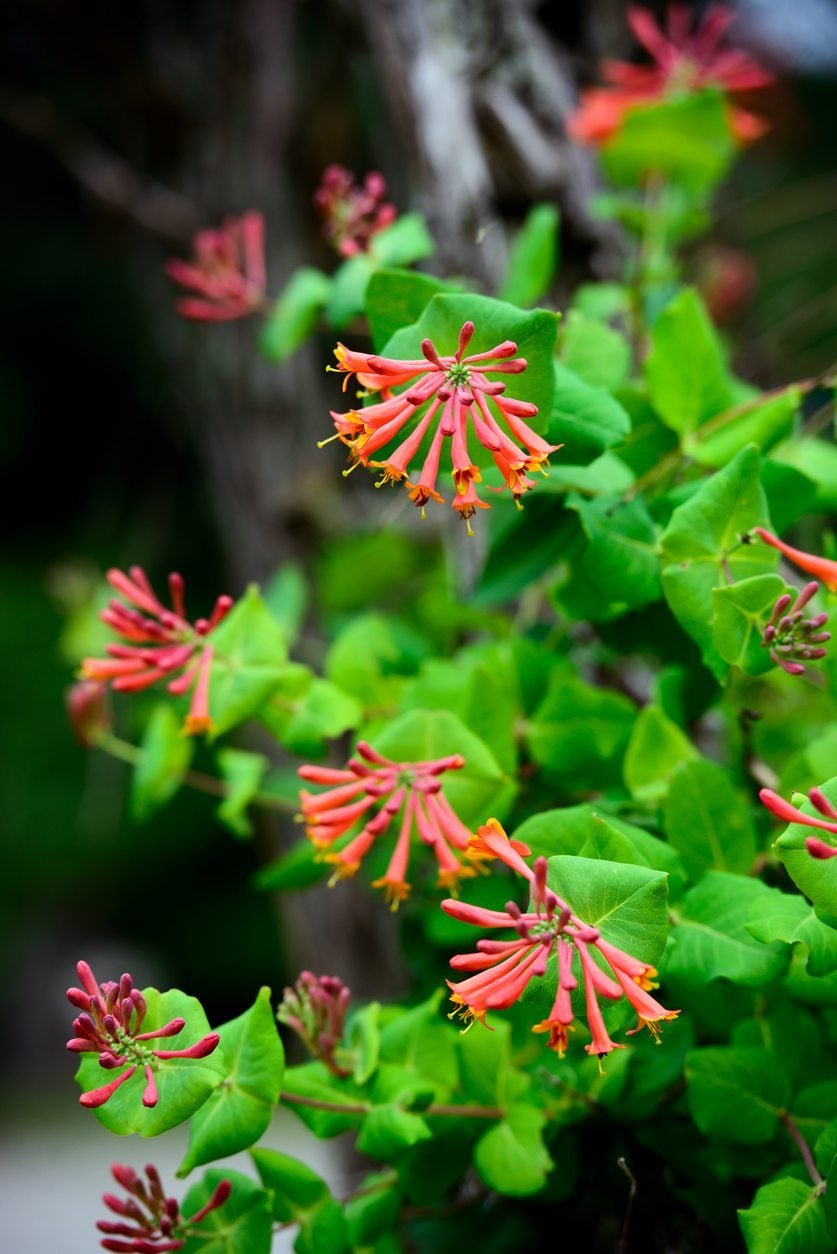Types Of Honeysuckle Plants: How To Tell Honeysuckle Shrubs From Vines


For many people, the intoxicating fragrance of honeysuckle (Lonicera spp.) conjures up memories of pinching off the base of a flower and squeezing a single drop of sweet nectar onto the tongue. In fall, the flowers are replaced by bright-colored berries that draw cardinals and catbirds to the garden. You'll find many honeysuckle varieties to choose from, with long-lasting flowers that bloom in shades of yellow, pink, peach, red and creamy white.
Different Kinds of Honeysuckles
The different types of honeysuckle include both shrubs and climbing vines. The vines climb by twining themselves around their supporting structure, and can't cling to solid walls. Most need spring pruning to keep them from growing out of control and becoming a tangled mass of vines. They regrow quickly, so don't be afraid to give them a severe cut.
Honeysuckle Vines
Trumpet honeysuckle (L. sempervirens) and Japanese honeysuckle (L. japonica) are two of the most ornamental of the honeysuckle vines. Both grow in USDA plant hardiness zones 4 through 9, but trumpet honeysuckle grows best in the Southeast, while Japanese honeysuckle thrives in the Midwest. Both vines have escaped cultivation and are considered invasive in some areas. Trumpet honeysuckle blooms in spring in shades of red and pink. Japanese honeysuckle produces pink or red blossoms from summer through early autumn. You can train both species to a trellis, or let it ramble as a ground cover. Mow vines used as ground cover with the blades set as high as they will go in late winter to get rid of the dead undergrowth and control the spread.
Honeysuckle Shrubs
When it comes to honeysuckle shrubs, winter honeysuckle (L. fragrantissima) -- grown in USDA zones 4 through 8 -- is an excellent choice for informal hedges or screens. It also makes a nice potted plant for areas where you will enjoy the lemony fragrance most. The first, creamy-white blossoms open in late winter or early spring and the bloom season continues for a long time. Sakhalin honeysuckle (L. maximowiczii var. sachalinensis) -- USDA zones 3 through 6 -- grows into shrubs similar in appearance and habit to winter honeysuckle, but the flowers are deep red. Some people find the fragrance of honeysuckle too strong for more than a brief exposure, and for them, there is freedom honeysuckle (L. korolkowii ‘Freedom'). Freedom produces unscented, white blossoms with a blush of pink. Despite their lack of fragrance, they still attract bees and birds to the garden.
Gardening tips, videos, info and more delivered right to your inbox!
Sign up for the Gardening Know How newsletter today and receive a free copy of our e-book "How to Grow Delicious Tomatoes".

Jackie Carroll has written over 500 articles for Gardening Know How on a wide range of topics.
-
 Looking For Plants To Give You The Soft And Fuzzies? Try These 5 Fuzzy Leaf Plant Options
Looking For Plants To Give You The Soft And Fuzzies? Try These 5 Fuzzy Leaf Plant OptionsLovers of texture, drama, silver foliage and tactile plants will adore these special sensory garden additions. These fuzzy leaf plant options will leave you all aglow
By Susan Albert
-
 Get Ready For A Summer Of Hummers! Grow These Full Sun Hummingbird Plants and Flowers
Get Ready For A Summer Of Hummers! Grow These Full Sun Hummingbird Plants and FlowersIf you’re lucky enough to enjoy a sunny backyard, make sure you are maxing out on your pollinator opportunities and grow these full sun hummingbird plants and flowers
By Tonya Barnett
-
 Honeysuckle Plants That Attract Mosquitoes
Honeysuckle Plants That Attract MosquitoesRecently, scientists have discovered a big problem: non-native honeysuckles might increase your yard’s mosquito population.
By Mary Ellen Ellis
-
 DIY Honeysuckle Wreath: How To Harvest And Use Honeysuckle
DIY Honeysuckle Wreath: How To Harvest And Use HoneysuckleWreaths lend a natural note to holiday decorations. Learn how to make a honeysuckle wreath for a keepsake you can use for years to come.
By Mary Ellen Ellis
-
 What Is Western Honeysuckle – How To Grow Orange Honeysuckle Vines
What Is Western Honeysuckle – How To Grow Orange Honeysuckle VinesWestern honeysuckle vines climb up some 33 feet (10 m.) and decorate the garden with sweet-smelling orange blossoms. Click this article for information about these vines including tips on how to grow orange honeysuckle in your home landscape.
By Teo Spengler
-
 Himalayan Honeysuckle Plants: Tips For Growing Himalayan Honeysuckles
Himalayan Honeysuckle Plants: Tips For Growing Himalayan HoneysucklesHimalayan honeysuckle plants develop a truly unique looking flower. It is a carefree blooming plant that is attractive to butterflies, bees and even hummingbirds. The blooms are followed by tiny purple berries. Learn more about the plant in this article.
By Bonnie L. Grant
-
 Coral Honeysuckle Info: How To Grow Coral Honeysuckle In The Garden
Coral Honeysuckle Info: How To Grow Coral Honeysuckle In The GardenCoral honeysuckle is a beautiful, fragrant, flowering vine native to the southern United States. It provides a great cover for trellises and fences that is the perfect alternative to its invasive, foreign cousins. Learn more coral honeysuckle info in this article.
By Liz Baessler
-
 Honeysuckle Seeds And Cuttings: Tips For Propagating Honeysuckle Plants
Honeysuckle Seeds And Cuttings: Tips For Propagating Honeysuckle PlantsThe non-invasive honeysuckle is a desirable garden plant for pretty flowers. Propagating honeysuckle can be done in several ways. To expand the reach of this pretty, shade-creating vine in your garden, follow the tips and guidelines found in this article.
By Mary Ellen Ellis
-
 Transplanting Honeysuckles: How To Transplant A Honeysuckle Vine Or Shrub
Transplanting Honeysuckles: How To Transplant A Honeysuckle Vine Or ShrubEven the most attractive plants must be moved around in the garden sometimes. Whether you have a vine or a shrub, transplanting honeysuckles isn't too hard, as long as you know what you are doing. The information in this article will help get you started.
By Teo Spengler
-
 Care Of Winter Honeysuckle: Tips On Growing Winter Honeysuckle Shrubs
Care Of Winter Honeysuckle: Tips On Growing Winter Honeysuckle ShrubsThe winter honeysuckle bush has delightfully fragrant flowers popular with gardeners and landscapers. You can even find unattended stands thriving at crumbling old homesteads and graveyards. Learn more about winter flowering honeysuckle plants in this article.
By Jackie Carroll